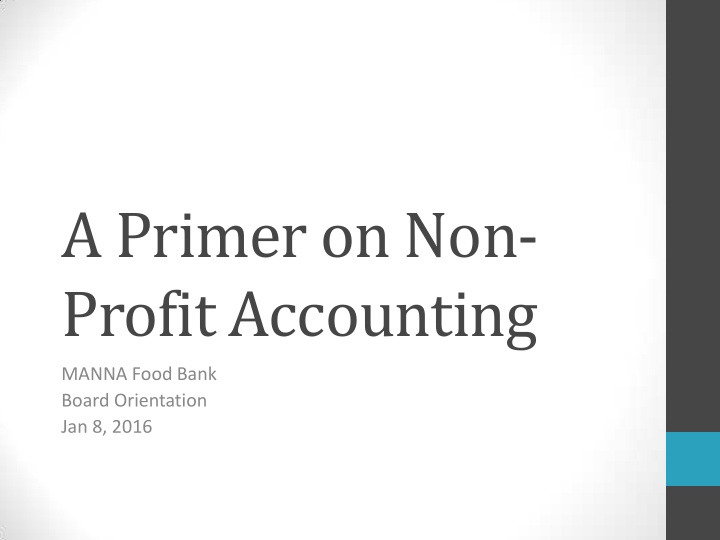



A Primer on Non- Profit Accounting MANNA Food Bank Board Orientation Jan 8, 2016
Some things you need to know: • Revenue recognition rules • Unlike the for-profit world, GAAP requires that revenues be recognized at the time of commitment (ie. Grant award letter, pledge, etc) provided the payment of funds is not contingent on specific performance criteria — in which case the revenues would might be recorded as unearned revenue; • Revenues may be recorded in one fiscal year but expensed in subsequent fiscal years — MANNA reflects these funds below the bottom line as “roll forward” funds for cash flow purposes • Restrictions on contributions • Revenues are recognized as either unrestricted, temporarily restricted, or permanently restricted based on the intent of the donor
Restrictions on Contributions con’t • Unrestricted contributions allow MANNA to use the funds in any way we see fit • Temporarily restricted funds mean that the funds can only be used for the purpose designated by the donor — restrictions are met and released either through use or passage of time, depending on the type of restriction • Permanently restricted funds: these are typically given as endowments; the corpus of the funds can never be used but the earnings from the funds can be drawn down and used by the organization based on the donor’s stipulations • Board-designated funds: from an accounting perspective, these are considered unrestricted funds (i.e. the donor did not stipulate any specific use of the funds) but the Board has decided they want to set aside funds for a particular use. The Board has the authority to release these funds for use, change the designation, etc
• Valuation of Inventory • MANNA’s inventory is comprised of 3 main types of product— donated product, purchased product, and TEFAP product (USDA); each of these product types has a different method of valuation • Donated Product: Each year, Feeding America contracts with a national accounting firm to conduct a study of the top products donated during the year and determine the FMV of a pound of donated product. This value per pound is then applied to all donated product received and distributed for the fiscal year. MANNA records the total receipts and distributions at the end of each fiscal year and restates its inventory on hand accordingly as of June 30. The current FMV of one pound of donated product is $1.70 • Purchased Product: At the end of each fiscal year, the value of the purchased product on hand is based on the actual costs on a per- item basis • TEFAP: The NC Dept of Ag provides the value of all USDA commodities
Valuation of Inventory con’t • At the end of each fiscal year, the inventory value of USDA commodities is adjusted based on the actual items received and distributed throughout the year. • Impact of Inventory on the Financial Statements • Contrary to what you would see in a for-profit setting, when distributions of product are greater than the amount of product received the result is a decrease in the net assets for the year; this is due to the fact that product received is recorded as revenue and product distributed is recorded as an expense.
The 990: Non-Profit Tax Return • This form is actually an information return rather than a tax return since MANNA is a 501(c)(3) organization; however there is a lot of very critical information contained in this document which is available to the public to view. One of the key items that donors often look at is the ratio of Program expenses versus fundraising and overhead expenses. This portion of the return is called a functional expense statement. • MANNA’s ratios are currently 94% Program, 3% Fundraising, and 3% Overhead; this is due to the way we are required to record inventory (as mentioned earlier) with donated product distributions comprising 73% of our total expenditures. • Two other major areas that are often reviewed by the public are the sections on board governance as well as the section on major program accomplishments — this is a great opportunity for MANNA to tell its story; we are free to include as much or as little detail as we choose.
Samples of Financial Package On a quarterly basis, the Board will receive a Packet of information that includes: • Statement of Position • Cash Balances including investment accounts • Receivables • Payables • Net Assets • Statement of Activities • Revenues: actual to budget with historical data • Expenses: actual to budget with historical data • Net gain/loss for period and year-to-date • Graphs of Historical Cash Balances versus current cash balances • Comparative analysis of sources of revenue
Recommend
More recommend